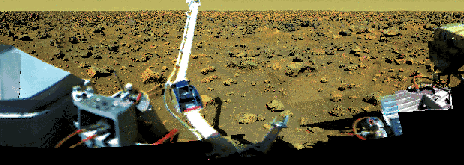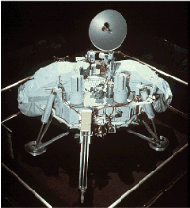 |
|
 |  |
| Viking lander (Ref) and two views of the Martian surface from Viking 1 (Ref) | |
In 1976 the Viking 1 and 2 landers undertook searches on the Martian surface for the chemical evidence of present or past life on Mars. The images shown below give a picture of one of the backup landers, and two different views of the Martian surface as photographed from Viking 1.
 |
|
 |  |
| Viking lander (Ref) and two views of the Martian surface from Viking 1 (Ref) | |
In addition to photgraphing the surface, the Viking landers undertook a series of experiments at two points on the surface to find evidence for life.

Recently there were a number of failed missions to mars. this site has some info on the failed lander mission, with links to other pages on the subject. It is thought that the climate orbiter was incorrectly navigated because engineers combining two computer programs into one did not correctly convert the units from english to metric systems.
The failure of the Mars lander involved some design flaw or timing error such as the lander turning off its landing rockets too early, in part due to software mismatches where English units were used in one place and metric units in another. There were also perhaps some fundamental management problems with the Jet Propulsion Laboratory (JPL) in Pasadena (where the Mars lander was designed and built). This could have ultimately contributed to y mis-communication between the engineers and the managers, and the "goal" of getting the thing made cheap and fast may have played a role. NASA (which runs JPL) has made an effort to reduce costs and has put forth the slogan "Faster, Better, Cheaper" which could really be viewed as "Faster, Cheaper, Probably Worse." This is changing as NASA has now slowed development of the next lander.
Now (2004) however, although the British lander "Beagle" has also failed, NASA has successfully landed the surface rovers Opportunity and Spirit. Much more information about these new successful missions is updated continuously (March 2004) and can be found here: Mars Rovers (latest updates are here ).